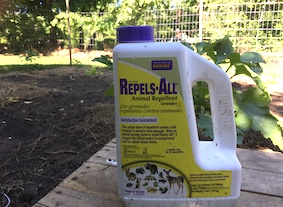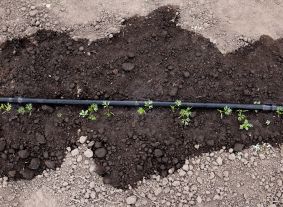Small Animal Repellents
Views: 1023

Animals of all sorts are unwelcome in the garden, and using a repellent of some sort becomes necessary. In my urban community garden the most common animal visitor we have are a few neighborhood cats. They are fairly harmless, usually just sitting in a patch of sunlight or taking a nap under the giant rhubarb leaves (the garden hose was quite a surprise to that napping cat!) but on occasion they’ll leave behind some feces or a hairball. Not cool.
In my new country vegetable garden I have a wealth of other creatures that come to visit. Two that I have seen for sure are rabbits and groundhogs, otherwise known as woodchucks (and I guess whistle pig and land beaver are other common names for this creature!). There’s also evidence of opossums, although I’ve never seem them on my property. And I can hear a pack of coyotes roaming down by the dairy farm every once in a while, too. But as far as my garden is concerned, the “bad guys” are the bunnies and the groundhogs.
Repellent Methods for the Garden
After the resident rabbit had its way with my perennial phlox and my flowering quince—both items that they ate to about 4 inches in height, poor things—I realized my nascent vegetable garden wouldn’t stand a chance if I didn’t take action. Here are some common animal repellent methods to block unwanted visitors and the damage they bring:
Movement. A friend swears by pinwheels, tassels and other items that catch the wind and create confusing movement to scare the animal.
Noise. Inconsistent noises can also scare away animals. For instance, aluminum pie plates that bang against each other by wind movement create noise. I’ve seen this work for birds. It’s helps if your garden is out of your own earshot.
Barriers. Aka, fencing. Whether it’s a segment of chicken wire circling individual plants or a large fenced enclosure around the entire garden, fencing can block animals from damaging your plants. Be sure the “holes” in the fence are small enough to block out the animal you’re having issues with; i.e. cattle fencing openings are big enough for bunnies and groundhogs to squeeze through, for sure.
Material repellents. No, I’m not talking poisons! Some products use odors and irritants to keep animals away. Mint smells keep rodents away, apparently. And some products use the urine of predatory animals to warn off prey animals such as rabbits. I have had success with a product called Repels-All from Bonide. The material, which is a more solid version of something like grated Parmesan cheese, has an irritating effect on the nasal passages of a variety of small animals.
The thing to keep in mind with the material repellents is their effectiveness over time and after weather events. For instance, the repellent odors can fade over time. My nasal irritant doesn’t hold up well after lots of rain and should be reapplied. Is that a lot of work? It’s just a little extra effort to ensure your hard work of growing your vegetables pays off for your own dinner plate and not for the bunny’s belly.
Meet Ellen Wells
When you’re raised on a farm, you can’t help but know a thing or two about gardening. Ellen Wells is our expert on edible gardening.…
Ellen's Recent Posts

Asparagus






